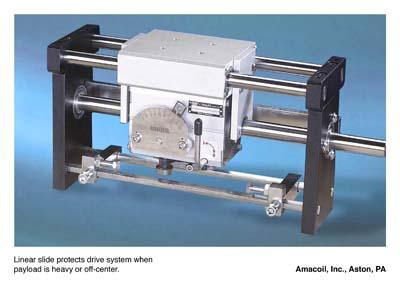
To enhance the load carrying efficiency of Uhing traverse drives and to prevent them from slipping, Amacoil has announced the availability of a linear bearing slide load carrier. The load carrier protects the rolling ring bearings from undue wear by assuring that weight and radial forces are not transmitted to the shaft-bearing interface.
Supported by end supports and guide rails, and riding on linear bearings, the load carrier accepts the full force of any payload attached to the Uhing traverse. Two yokes extend down from the load carrier. The traverse pushes against the yokes to move the load linearly. The yokes are not screwed or bolted to the traverse. Therefore no forces are placed on the traverse other than the lateral resistance to movement of the load carrier. This configuration maximizes the performance efficiency and lifespan of the Uhing traverse.
Uhing traverse side thrust capacity is factory-set by installing the rolling ring bearings under fixed pressure. The load carrier keeps additional pressure and forces off the bearings optimizing their thrust capacity and lifespan. Because the load carrier guide rails are perfectly parallel with the Uhing drive shaft, smooth linear movement is enhanced while the possibility of a cantilevered or off-center load causing the drive to bind or seize is virtually eliminated.
Three styles of load carriers are available to accommodate varying payload styles and weights. The standard model SLS and the model L2 for heavy duty loads mount on top of the Uhing drive. A third model, the L4, mounts to the back of the Uhing drive and features a load-supporting surface which extends above the top of the drive by only 1.0 to 2.0mm. This is useful in situations where a load carrier is needed but vertical space is limited. Lightweight loads do not require the load carrier.
Related Glossary Terms
- parallel
parallel
Strip or block of precision-ground stock used to elevate a workpiece, while keeping it parallel to the worktable, to prevent cutter/table contact.
- payload ( workload)
payload ( workload)
Maximum load that the robot can handle safely.
